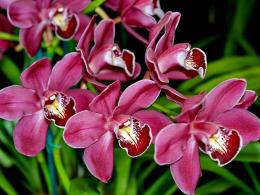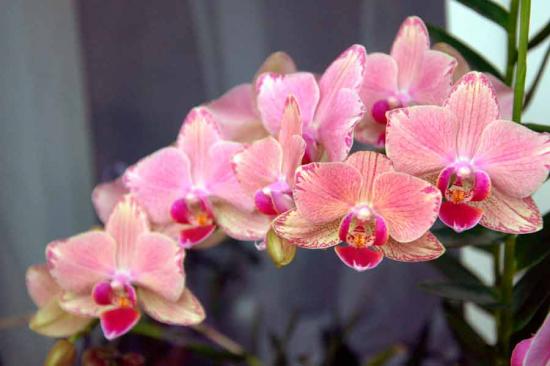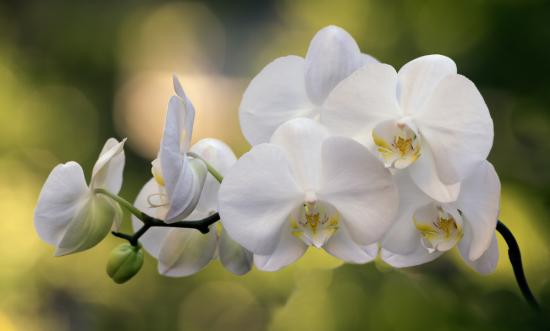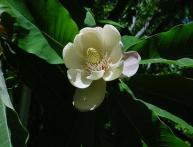A story about an orchid: features of planting and growing a flower

The orchid is a tropical exotic plant, which is characterized by a high level of popularity in our country. Depending on the type orchid can have various sizes. It is characterized by quite beautiful flowering and is therefore grown not only in private houses and apartments, but also in public buildings.
Content:
Optimal conditions
To ensure long and lush flowering of an orchid, it needs to provide optimal growing conditions, which include:
- Temperature
- Lighting
- Substrate
- Humidity
If the flower is grown in the traditional way, then it does not need additional lighting. The orchid needs enough light to enter through the window. When growing a plant on a southern windowsill, it needs to be protected from the negative effects of direct sunlight.
When placing a plant on the north side in winter, it needs to be provided with additional lighting. Temperature requirements directly depend on the type of orchid. On average, the plant is grown at a temperature of 16-26 degrees.
Orchid loves moisture very much, which requires strict adherence to watering rules. But, in this case, you should not overdo it, since excessive watering can lead to the death of the plant. The frequency of watering the crop should be 1-3 times.When the need for watering arises, the pseudobulb of the flower shrinks.

If the plant is provided with excessive watering, this leads to rotting of the roots and yellowing of the leaves at the edges. Watering the plant is carried out with pre-settled water, which is at room temperature. It must be poured into a container in which the pot with the plant is placed. After the substrate becomes wet, the pot with the plant must be removed.
The orchid is demanding on the substrate. That is why it is necessary to strictly adhere to the technology of its production. In order to ensure excellent air permeability and eliminate the possibility of rotting of the root system of the flower, it is necessary to prepare a substrate based on charcoal and pine bark.
In some cases, chopped sphagnum is added to the substrate. In order to ensure full growth of the orchid, it is necessary to add leafy soil to the substrate. If optimal conditions are provided growing orchids, this will lead to long and abundant flowering.
Landing Features
Planting an orchid at home can be done in several ways. In this case, it is necessary to select high-quality planting material. To sterilize the cuttings before planting, it is recommended to use fungicides. Most often, an orchid is planted in a pot, into which one third is filled with drainage made of foam plastic, expanded clay or broken brick.
The cutting must be placed directly on the drainage, to which the roots are attached using soft wire or thread. Next, the plant is covered with pre-prepared soil.In this case, it is necessary to ensure that the horizontal part of the stem remains on the surface. If a basket is used for growing, then drainage is not needed in this case. This is explained by the possibility of unhindered oxygen supply to the roots.
At the bottom of the basket, a wire mesh is secured, which can be replaced with moss or bark. The roots of the cuttings are located on the mesh, which are covered with substrate. To increase the moisture capacity of the soil, the slots in the basket are closed with moss. Quite often, orchids are grown in special blocks.
They have a special hook with which they are attached to the wall. If in the future the orchid is provided with normal humidity conditions, then you need to line the bottom of the block with moss. The plant is applied to the block and covered with moss on top. The orchid is secured with fishing line or nylon thread. Planting an orchid can be done in several ways. The choice of a particular one directly depends on the wishes of the grower.
Video about proper and complete care of an orchid:
Care after disembarkation
After planting the orchid, it needs to be provided with appropriate care. If the flower is provided with optimal conditions, then it needs to be watered once every two weeks. This procedure is carried out only when the substrate dries. The orchid needs abundant watering. The root system of the plant will tell you about the characteristics of moisture.
When the roots are green in color, one can judge the sufficiency of glaze. If the color of the roots turns brown, then it is necessary to reduce the frequency of watering. To water the orchid, you must use settled tap water, the temperature of which is from 22 to 24 degrees.To avoid infection of the foliage of the crop with rot, it is not recommended that water come into contact with it. That is why watering the plant should be done as carefully as possible.
In order to stimulate the plant to bloom, it must be placed in a cool place and watering reduced. To feed the orchid, you must use special liquid fertilizers, which can be purchased at a specialty store. The procedure is recommended once a month. If the desire arises, you have the opportunity to prepare the fertilizer yourself.

During the growing season, it is recommended to apply nitrogen fertilizers. After a certain time, the root system of the flower grows, which requires replanting. For this purpose, it is necessary to use a container that is slightly larger in diameter than the previous one. A drainage is placed at its bottom, to which the flower is attached. After this, it must be covered with soil.
The orchid is a unique flower with which you can decorate any room. Caring for an orchid is quite simple, and therefore any gardener can do it. In this case, the plant must be provided with optimal growing conditions, as well as watering and feeding, which will lead to its abundant flowering.











Comments
I especially like orchids with white flowers, like the one in the photo in this article. Sometimes on the street, if I see orchids on someone’s windowsill, I stare at them. I myself have not yet decided to get this plant, I am afraid that it will disappear or not bloom.